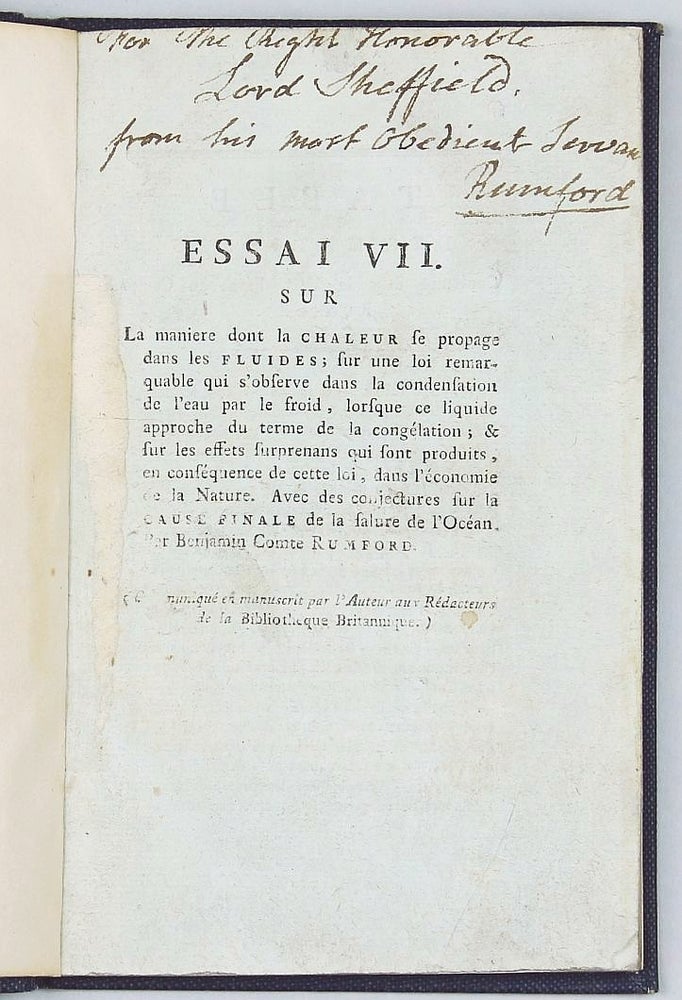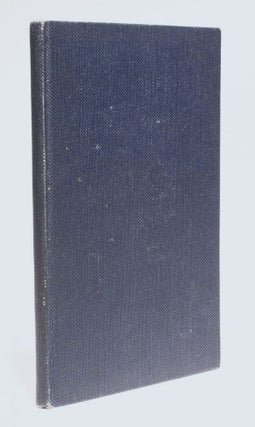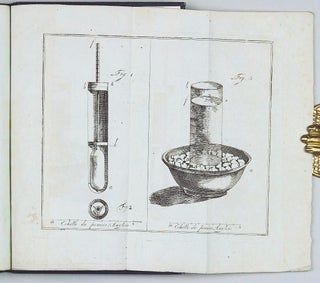Dedication copy, signed by Rumford
Essai VII. sur la manière dont la chaleur se propage dans les fluides.
Geneva: 1797.
1st Edition. Hardcover. Very Good. Item #002242
Offprint from: Bibliotheque Britannique, Sciences et Arts. Vol. 5 [Geneva, 1797]. 8vo (199 x 127 mm). iv, 104 pp. One folding engraved plate. Printed on blue paper. Inscribed and signed by Rumford on title-page ("to the right honorable Lord Sheffield, from his most obedient servant Rumford"). Provenance: Lord Sheffield (dedication by Rumford on title-page); Walter Scott Thompson (his bookplate to front pastedown). Later cloth (extremities little rubbed). Internally only little age-toned, title page with glued residue of flyleaf paper at gutter margin (not affecting text), inscription slightly trimmed at top and fore-margin. ----
DSB XIII, p.351. FIRST EDITION of Rumford's essay on the propagation of heat in fluids. Rumford is best known for his contributions to the theory of heat. At the end of the 18th century the predominant theory of heat was the so-called caloric theory, according to which heat was a fluid substance that flowed into bodies when they were heated and flowed out of them as they cooled. The success of this theory in explaining then known phenomena is reflected in many terms, such as "heat flow" and "calorie," still used by physicists today. "In 1797 he published the description of a device for proving gunpowder, which was generally accepted as the standard method by both the British and the Bavarian armies. It was during his investigations of cannon that he was impressed by the large amount of heat generated in cannon barrels by the explosion of gunpowder even when no ball was being fired. He was thus led to accept the vibratory theory of heat, which he championed actively all his life. Thompson's most famous experiment in this area was his demonstration of the process of boring cannon with a dull drill, which he carried out in the arsenal at Munich. Because the heat generated in this process seemed limitless, he reasoned that a fluid caloric did not exist. Thompson carried out many other experiments to demonstrate the reasons for his disbelief in the caloric theory. He unsuccessfully attempted to determine whether heat had weight, which would be an attribute of a fluid; he weighted, at different temperatures, fluids that had markedly different specific heats and heats of fusion. He studied the anomalous expansion of fusion. He studied the anomalous expansion of water between 4°C and 0°C to show that the concept that thermal expansion is caused by fluid caloric taking up space was false. He never realized the connection between heat and energy, although he did carry on experiments to demonstrate spontaneous interdiffusion of different density liquids at constant temperature, and he postulated that fluids are in constant random motion." (DSB).
Price: 1,400 € * convert currency
Delivery time up to 10 days. For calculation of the latest delivery date, follow the link: Delivery times
Lieferzeit max. 10 Tage. Zur Berechnung des spätesten Liefertermins siehe hier: Lieferzeiten




